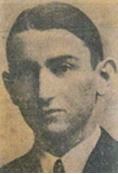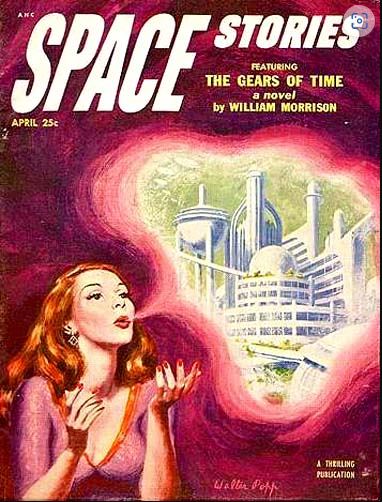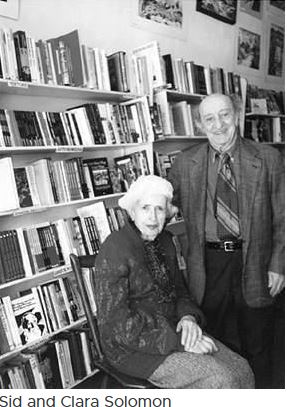Comments
William Morrison (1906-1980) published dozens of stories in science fiction magazines from 1942 through 1958. A couple were called “complete novels” back in the days when 40 magazine pages qualified for the title, but the only true novel was this utterly forgotten juvenile. Mel Oliver and Space Rover on Mars, though it was supposed to be the first of a series for juveniles, vanished into immediate obscurity. It was never reprinted in hardback and until 2017 it saw no English reprintings of any kind. Oddly, it had two Dutch paperbacks. Although the reviews were generally good, the book failed.
The total lack of book product – there’s never been a short story collection either – has kept to make Morrison virtually unknown, to the point where most people don’t realize that it is a pseudonym – even though his real name is forthrightly revealed right there on the back flap. He has a story and it’s a good one.
Joseph Samachson is another of the working scientists who hid his identity when writing science fiction, like Eric Temple Bell (John Taine) and John R. Pierce (J.J. Coupling). As a young prodigy, he started at the top, earning a Ph.D. in Chemistry from Yale at the age of 23. He held a series of prestigious positions through the 1930s, but abruptly left to enter the world of freelance writing, symbolically killing off his career with his other fiction hardback, 1937’s Murder of a Professor as by John Miller. It couldn’t have been a major part of his income, but he inevitably gravitated toward writing some low-end science fiction for the pulps, even ghosting a couple of Captain Future stories under the house name of Brett Sterling. He wrote almost an equal number for mystery and western pulps as well.
Pulps were subordinate to another field also not normally associated with doctorates: comic books. He was a prized writer for DC Comics, a versatile and prolific penman they could throw at any title, from Batman, Superman, Aquaman, and Starman to the Boy Commandos, Stripsey and Wing, Two-Gun Percy, Liberty Belle, and Mike Gibbs, Guerilla. He’s also credited with creating Tomahawk, a Revolutionary War frontiersman, before he phased out of the field in 1951.
Samachson returned to fiction writing in 1949, producing more than 50 stories over the next decade, mostly in the lower-end magazines but with appearances in Astounding, Galaxy, and F&SF, as well as mainstream magazines. Mel Oliver is part of this burst of activity, no doubt a logical step in Samachson’s mind. Perhaps the failure of the novel is what drove him back to comics for a brief time in 1955 and 1956, when he co-created J’ohn J’onzz, Martian Manhunter.
Unlike so many others, Samachson had a successful third act. Not only did he return to academia, becoming Associate Clinical Professor of Biochemistry at Loyola University, Chicago, but he has the not inconsiderable achievement of being part of the team that discovered that calcium could be an antidote from strontium poisoning in 1957 at Montefiore Hospital in New York. He also produced nearly a dozen nonfiction books, for adults and children. almost all of them with his wife, Dorothy.
Gnome Notes
According to Greenberg, Mel was supposed to be the start of a series of children’s books, but he never had the money to afford the writers he wanted. Presumably he was contrasting children’s books with young adult novels, which he published several of.
The book was designed by Sidney Solomon, a name not seen on any other Gnome book. A Sidney Solomon is also credited as the designer for several f&sf titles from Frederick Fell and an auction catalog lists correspondence between him and Shasta Publishers. My guess is the name refers to the book designer Sidney Solomon (1911-2004), who led a colorful life as part of the Vanguard Group in the 1930s, the New Trends Group in the 1940s, and the Libertarian Book Club from the 1940s through the 1980s.
Kirkus Reviews gave the expected publication date as April 25, 1954.
Reviews
Anthony Boucher, The Magazine of Fantasy & Science Fiction, September 1955
I ‘d say this is the most enjoyable non-Heinlein s.f. for the young since … 1952.
Ellen Lewis Buell, The New York Times Book Review, August 8, 1954
Mr. Morrison’s fantastic creatures are not as brilliantly devised as Robert Heinlein’s flat cats and bouncers, and his mystery is pretty obvious.
Contents and Original Publication
• Chapters 1-14 (original to this volume).
Bibliographic information
Mel Oliver and Space Rover on Mars, by William Morrison (pseud. of Joseph Samachson), 1954, copyright registration 15Jul54, Library of Congress catalog card number 54-7254, title #41, back panel #26, 191 pages, $2.50. 4000 copies printed. Hardback, yellow boards with red drawings of Mel Oliver and Space Rover on front and spine lettered in red. Jacket design by Emsh. “FIRST EDITION” on copyright page. Printed in the U.S.A. by H. Wolff. Designed by Sidney Solomon. Back panel: 31 titles. Gnome Press address given as 80 East 11th St., New York 3.
Variants
None known.
Images








